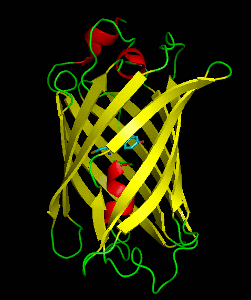Dronpa
Dronpa is a photoactivatable fluorescent protein derived from a species of coral in the genus Pectiniidae. It is widely used in cell biology and molecular biology for its ability to switch between a fluorescent and non-fluorescent state upon exposure to specific wavelengths of light.
Discovery and Origin[edit | edit source]
Dronpa was first discovered in a species of coral from the genus Pectiniidae. The protein was named "Dronpa" as a portmanteau of "Dron" (a Japanese word for "turn on") and "pa" (for photoactivation).
Structure and Properties[edit | edit source]
Dronpa belongs to the family of GFP-like proteins and shares a similar beta-barrel structure. It exhibits a unique ability to switch between a bright fluorescent state and a dark state when exposed to light of specific wavelengths. This property is known as photochromism.
Photoactivation[edit | edit source]
Dronpa can be switched on (activated) by exposure to cyan light (around 488 nm) and switched off (deactivated) by exposure to ultraviolet light (around 405 nm). This reversible switching makes it a valuable tool for super-resolution microscopy and other advanced imaging techniques.
Applications[edit | edit source]
Dronpa is used extensively in live-cell imaging due to its reversible photoactivation properties. It allows researchers to track the movement and interaction of proteins within living cells with high spatial and temporal resolution. Some of the key applications include:
- Fluorescence resonance energy transfer (FRET)
- Photoactivated localization microscopy (PALM)
- Fluorescence recovery after photobleaching (FRAP)
Advantages[edit | edit source]
The main advantages of Dronpa over other fluorescent proteins include its high brightness, photostability, and the ability to be repeatedly switched on and off. These properties make it particularly useful for long-term imaging studies.
Limitations[edit | edit source]
Despite its many advantages, Dronpa has some limitations. The requirement for specific wavelengths of light for activation and deactivation can limit its use in certain experimental setups. Additionally, the potential for phototoxicity due to prolonged exposure to activating light is a concern in live-cell imaging.
Variants[edit | edit source]
Several variants of Dronpa have been developed to improve its properties or to provide different colors of fluorescence. These include:
- Dronpa-2
- mEos2
- mMaple
See Also[edit | edit source]
- Green fluorescent protein
- Photoactivatable fluorescent proteins
- Super-resolution microscopy
- Live-cell imaging
References[edit | edit source]
External Links[edit | edit source]
Search WikiMD
Ad.Tired of being Overweight? Try W8MD's physician weight loss program.
Semaglutide (Ozempic / Wegovy and Tirzepatide (Mounjaro / Zepbound) available.
Advertise on WikiMD
|
WikiMD's Wellness Encyclopedia |
| Let Food Be Thy Medicine Medicine Thy Food - Hippocrates |
Translate this page: - East Asian
中文,
日本,
한국어,
South Asian
हिन्दी,
தமிழ்,
తెలుగు,
Urdu,
ಕನ್ನಡ,
Southeast Asian
Indonesian,
Vietnamese,
Thai,
မြန်မာဘာသာ,
বাংলা
European
español,
Deutsch,
français,
Greek,
português do Brasil,
polski,
română,
русский,
Nederlands,
norsk,
svenska,
suomi,
Italian
Middle Eastern & African
عربى,
Turkish,
Persian,
Hebrew,
Afrikaans,
isiZulu,
Kiswahili,
Other
Bulgarian,
Hungarian,
Czech,
Swedish,
മലയാളം,
मराठी,
ਪੰਜਾਬੀ,
ગુજરાતી,
Portuguese,
Ukrainian
Medical Disclaimer: WikiMD is not a substitute for professional medical advice. The information on WikiMD is provided as an information resource only, may be incorrect, outdated or misleading, and is not to be used or relied on for any diagnostic or treatment purposes. Please consult your health care provider before making any healthcare decisions or for guidance about a specific medical condition. WikiMD expressly disclaims responsibility, and shall have no liability, for any damages, loss, injury, or liability whatsoever suffered as a result of your reliance on the information contained in this site. By visiting this site you agree to the foregoing terms and conditions, which may from time to time be changed or supplemented by WikiMD. If you do not agree to the foregoing terms and conditions, you should not enter or use this site. See full disclaimer.
Credits:Most images are courtesy of Wikimedia commons, and templates, categories Wikipedia, licensed under CC BY SA or similar.
Contributors: Prab R. Tumpati, MD

